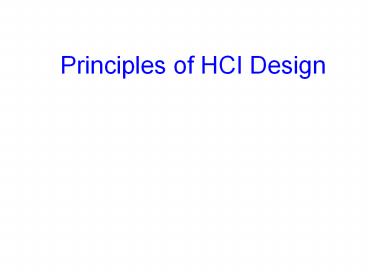Principles of HCI Design - PowerPoint PPT Presentation
Title:
Principles of HCI Design
Description:
Principles of HCI Design Don't go to the right? Where do you plug in the mouse? Traditional Software Design Waterfall model of software life cycle User Centered ... – PowerPoint PPT presentation
Number of Views:231
Avg rating:3.0/5.0
Title: Principles of HCI Design
1
Principles of HCI Design
2
Don't go to the right?
3
Where do you plug in the mouse?
4
(No Transcript)
5
(No Transcript)
6
(No Transcript)
7
(No Transcript)
8
(No Transcript)
9
(No Transcript)
10
(No Transcript)
11
Traditional Software Design
- Waterfall model of software life cycle
12
User Centered Design
- There should not be a black box for the user!
- The User SHOULD
- Drive all user interface design decisions
- Determine goals and set priorities
- Agree upon all goals that will be used in
designing the user interface
13
User-Centered Project Life Cycle
User/Task Analysis I Set Usability Goals I Design
Interface I Evaluate Designs I Build
Prototype I Test Prototype
Test Okay?
14
Iteration is the key!
- No design will be perfect in the first time.
- Interactive systems cannot be completely
specified from the beginning of the life cycle. - Users need to be involved all the time.
- Evaluation and testing should be done throughout
the design process. - Design and testing should be repeated
iteratively. - Prototypes, rather than real systems, can be used
for testing.
15
How to Start?
- Intelligent Borrowing
- Plagiarizing or Good Design Practice
- http//www.freewebtemplates.com/
- Getting to Know Existing Frameworks
- Guidelines and standards
- IBM Web Design Guidelines (http//www-3.ibm.com/ib
m/easy/eou_ext.nsf/publish/558) - Ameritech User Interface Standard(shttp// www.
ameritech.com1080/corporate/testtown/library/stan
dard/index.html)
16
Getting started
- Getting to Know Existing Frameworks
- Convention
- User is already familiar with the process or
arrangement from other interfaces - Most of user interface design requires designers
to work within the tight constraints of existing
designs
17
- Studying existing applications
- look at systems users already know
- Copy interaction techniques
- copy the style of menu selection, organization of
screen elements, etc. (where appropriate) - Understand why design was done in the way it was
done with the existing interface
18
(No Transcript)
19
(No Transcript)
20
(No Transcript)
21
(No Transcript)
22
(No Transcript)
23
(No Transcript)
24
Methods of Iterative Design
- Scenario Generation
- Choosing Representative Scenarios
- Comprehensive
- Critical Task
- Random
- Scenario Validation Review
- Key stakeholders first
- Group reviews later
25
Methods of Iterative Design
- Deriving Storyboards from Scenarios
- Paper Prototyping
- Explore constraints
- Study standards guidelines
26
Methods of Iterative Design
- Building an interactive rapid prototype from a
paper prototype. - Testing the Prototype with Users.
- Iteration Control
- Each iteration has a specific usability goals.
27
Prototype































